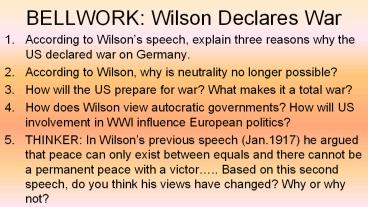BELLWORK: Wilson Declares War PowerPoint PPT Presentation
1 / 10
Title: BELLWORK: Wilson Declares War
1
BELLWORK Wilson Declares War
- According to Wilsons speech, explain three
reasons why the US declared war on Germany. - According to Wilson, why is neutrality no longer
possible? - How will the US prepare for war? What makes it a
total war? - How does Wilson view autocratic governments? How
will US involvement in WWI influence European
politics? - THINKER In Wilsons previous speech (Jan.1917)
he argued that peace can only exist between
equals and there cannot be a permanent peace with
a victor.. Based on this second speech, do you
think his views have changed? Why or why not?
2
Review The American Homefront
3
WWI in the Americas
- Is the U.S. a trendsetter?
4
Involvement in the Americas
- Bolivia Severed relations with Germany - April
13, 1917 - Brazil Severed relations with Germany - April
11, 1917 Declared war on Germany - Oct 26, 1917
- Costa Rica Severed relations with Germany - Sept
21, 1917 Declared war on Germany - May 23, 1918 - Cuba Declared war on Germany - April 7, 1917
- Ecuador Severed relations with Germany - Dec 8,
1917 - Guatemala Declared war on Germany - April 23,
1918 - Haiti Declared war on Germany - July 12, 1918
- Honduras Declared war on Germany - July 19, 1918
- Nicaragua Declared war on Germany and
Austria-Hungary - May 8, 1918 - Panama Declared war on Germany - April 7, 1917
Declared war on Austria-Hungary - Dec 10, 1917 - Peru Severed relations with Germany - Oct 6,
1917 - Uruguay Severed relations with Germany - Oct 7,
1917
5
ALLIED POWERS CENTRAL POWERS NEUTRAL COUNTRIES
6
WWI in the Americas Case Study Cuba
- After their victory in the Spanish-American War,
the U.S. occupied Cuba from January 1899 - May
1902. The occupation had three goals - Make Cuba into a self-governing colony with
secure economic policies and political stability
(better than full colonial occupation) - Created a huge opposition movement, but the U.S.
bought off the opposition army by offering to
purchase its arms an offer that hungry,
unemployed soldiers could not refuse. - Repair war destruction and promote economic
recovery to provide services necessary for U.S.
occupation - Launched public works programs, sanitation (led
to major yellow fever outbreak), created a
national education system (designed to instill
U.S. principles, even the textbooks were
translated American texts), established military
bases (Guantanamo Bay) all paid for by the Cuban
Treasury.
7
WWI in the Americas Case Study Cuba
- 3. Absorb Cuba into the United States economic
sphere of influence - American government protected U.S. business
interests, so they poured capital into sugar and
railroad construction. 1903 trade agreement cut
the tariff on Cuban sugar exported to the U.S.
and in return, Cuba reduced taxes on imported
U.S. goods. - In 1902, the U.S. transferred power to the Cuban
government. As a condition of the transfer, the
new constitution implemented the requirements of
the Platt Amendment, which among other things
gave the United States the right to intervene
militarily in Cuba. This will cause more U.S.
occupations!!!
8
WWI in the Americas Case Study Cuba
- Directions
- You are now going to read about the end of U.S.
occupation and Cubas involvement in WWI. - Start with Dependent Development and Popular
Struggle in the Latin American textbook pgs.
393-397 - As you read, complete the corresponding worksheet
? due Thursday 4/30
9
WWI in the Americas Case Study Cuba
- Effects of U.S. occupation
- Yellow Fever
- Dependence on U.S.
- The rapid and huge influx of U.S. investment into
sugar enabled the larger mills to buy surrounding
land and create monopolies - Impoverished rural areas and peasants
- Slave-like conditions
- Mills imported cheap labor from other Caribbean
islands (Jamaica Haiti) - Unemployment in agriculture created massive
growth of cities (poor living conditions) - Sugar monopolies controlled the railroads and
used them for their own benefit - By 1913, U.S. companies invested 200 million
into sugar, which accounted for 1/5 of total U.S.
investments in all of L.A.
10
Involvement in the Americas
- Reasons for Involvement
- WWI disrupted markets for L.A. goods and made it
difficult to import necessary manufactured
products - Threat of submarine warfare
- As a result, economy shifted from agriculture to
manufacturing in order to produce these necessary
goods - Declines in price levels of Latin Americas
exports encouraged a further growth in
manufacturing - Encouraged by U.S.
- Although manufacturing increased,
industrialization was almost completely limited
to light consumer good industries - High poverty remained
- Impact of Involvement
- The U.S. will emerge from WWI as the worlds
principal industrial and financial power, and
replaced England as the major source of foreign
investments in Latin America - Continuing the big stick and dollar diplomacy
policies of their predecessors, Democratic and
Republican administrations used armed
intervention and economic pressure to expand U.S.
control over the Caribbean area. - By the end of the period, there was deep Latin
American resentment of these strong-arm tactics - Countries push for total economic and political
independence

